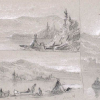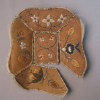Relatives/Heritage items
Displaying 1581 - 1600 of 4694 Relatives
Browsing allows you to see all the records for relatives and heritage items in the GKS. You can also search by material made, and/or filter by nations. To search by material made, type the material's name, by example 'leather', in the box below and click “Apply.” You can select multiple nations from the dropdown list by pressing “Ctrl” (on PC) or “Command” (on Mac) and clicking, then select “Apply.”
Flat, slate firemaking tool or gorget with three holes and tapered ends. Dr. Oronhyatekha Archeology collection.
Item has two attributions. LD and AC claim it is a firemaking tool; Dr. O catalogue attribute it as a stone gorget.
A surrender of a portion of a lot on the second concession of Tyendinaga, by the Mohawks Indians.
Single moccasin made from tanned, smoked hide and elaborated with quill work and deer dew claws. The moccasin is constructed of one main piece with a tongue added. Possibly Huron-Wendat. Originally from the Bibliothèque Nationale du France.
Bone pendant with beautifully and meticulously incised thunderbird motif. Dr. Oronhyatekha archaeology collection.
Odawa freshwater eel skin from Walpole Island used for medicinal purposes. Natural pattern of skin resembles herringbone, chevron and diamond motifs. Dr. Oronhyatekha Ethnology collection.
Partially complete, fine-tooth bone comb. Dr. Oronhyatekha Archeology collection.
Report transmitted by the SGIA to the Executive Council regarding a deed of surrender in which four islands were granted to the Crown by the Chippewas Tribes of Lakes Simcoe, Huron, and Couchiching. See IT188 - Manuscript Original
This relative, a small drawstring pouch, includes cross and hooked motifs. The pouch is composed of two rectangular bottom sections and one top panel sewn along one side. The top panel has been cut with slits for hide drawstring, with two looped handles tied at
This moosehair embroidered bark basket is work that is characteristic of the Wendat (Huron)of Wendake, Quebec, 19C souvenir arts production. The style of floral motifs suggests that the work dates from the 1830s to late 1840s.
This pouch depicting the Underwater Panther is of Eastern Great Lakes origin. It dates from around 1800.
George Strange Boulton surrendered 200 acres of land located in Alnwick Township to Samuel Peters Jarvis in consideration of one hundred pounds lawful money. The land is to be held in trust for the Mississauga Indians.
Gunstock club, attributed to the Oneida. Wooden shaft set with iron blade. Triangular chip carving forms possible zig-zag or lightning lines. A hawk, eagle or thunderbird carrying an arrow in talons found on each side of upper portion of shaft. Red, and possibly black paint
George Strange Boulton has granted to Samuel Peters Jarvis, 200 acres of land located in Alnwick Township for the sum of one hundred and fifty pounds, to be held in trust for the Mississauga Indians.
Single moccasin made of smoked moosehide elaborated with porcupine quill work and metal cones. Originally from the Bibliothèque Municipale de Versailles.
William Charles Hume, has appointed Skeffington Connor, of the City of Toronto, to act as his power of attorney since he has relocted to Ireland. He requests that Skeffington execute and deliver a deed for a parcel of land location in Orillia.
This is a chalk drawing of a scene on the north east shore of Georgian Bay, with figures, possibly Anishnaabe. The drawing is by Thomas Mower Martin.
In consideration of five shillings lawful money, John H. Dunn, William Hepburn, and George Herchmer Markland do surrender unto the Crown a tract of land previously conveyed to them by George Strange Boulton in trust for the Mississaga Tribe of Indians of Rice and Mud
Several tracts of land conveyed to Samuel P. Jarvis by various individuals held in trust for a variety of Aboriginal groups and lands are to be surrendered to Her Majesty the Queen in consideration of five shillings. This item is a copy of original document
This is a silver albumen photograph of the town of Wendake (Lorette). It was taken during the later nineteenth century.
 Knowledge Sharing Platform
Knowledge Sharing Platform













